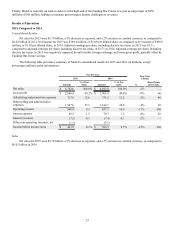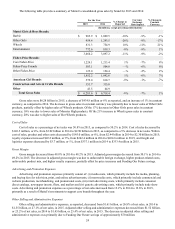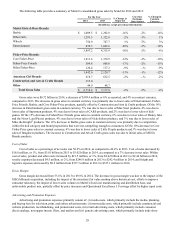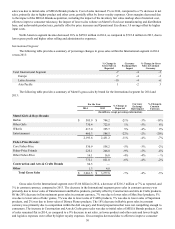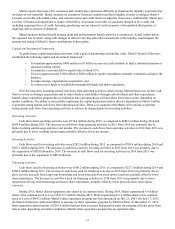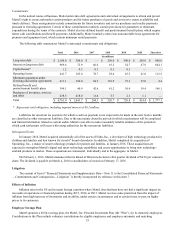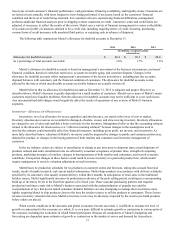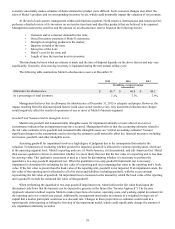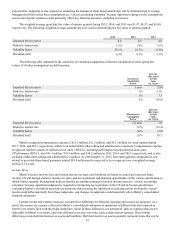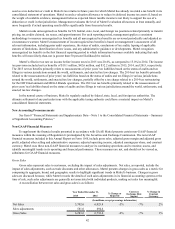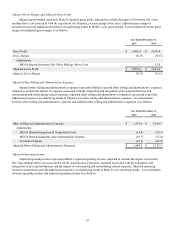Mattel 2015 Annual Report Download - page 37
Download and view the complete annual report
Please find page 37 of the 2015 Mattel annual report below. You can navigate through the pages in the report by either clicking on the pages listed below, or by using the keyword search tool below to find specific information within the annual report.33
Mattel expects that some of its customers and vendors may experience difficulty in obtaining the liquidity required to buy
inventory or raw materials. Mattel monitors its customers’ financial condition and their liquidity in order to mitigate Mattel’s
accounts receivable collectibility risks, and customer terms and credit limits are adjusted, if necessary. Additionally, Mattel uses
a variety of financial arrangements to ensure collectibility of accounts receivable of customers deemed to be a credit risk,
including requiring letters of credit, factoring, purchasing various forms of credit insurance with unrelated third parties, or
requiring cash in advance of shipment.
Mattel sponsors defined benefit pension plans and postretirement benefit plans for its employees. Actual returns below
the expected rate of return, along with changes in interest rates that affect the measurement of the liability, would impact the
amount and timing of Mattel’s future contributions to these plans.
Capital and Investment Framework
To guide future capital deployment decisions, with a goal of maximizing stockholder value, Mattel’s Board of Directors
established the following capital and investment framework:
• To maintain approximately $800 million to $1 billion in year-end cash available to fund a substantial portion of
seasonal working capital;
• To maintain a year-end debt-to-capital ratio of about 35%;
• To invest approximately $180 million to $200 million in capital expenditures annually to maintain and grow the
business;
• To make strategic opportunistic acquisitions; and
• To return excess funds to stockholders through dividends and share repurchases.
Over the long term, assuming annual cash flows from operating activities remain strong, Mattel plans to use its free cash
flows to invest in strategic acquisitions and to return funds to stockholders through cash dividends and share repurchases.
Mattel’s share repurchase program has no expiration date and repurchases will take place from time to time, depending on
market conditions. The ability to successfully implement the capital deployment plan is directly dependent on Mattel’s ability
to generate strong annual cash flows from operating activities. There is no assurance that Mattel will continue to generate
strong annual cash flows from operating activities or achieve its targeted goals for investing activities.
Operating Activities
Cash flows from operating activities were $734.6 million during 2015, as compared to $888.6 million during 2014 and
$698.4 million during 2013. The decrease in cash flows from operating activities in 2015 from 2014 was primarily due to
higher working capital usage and lower net income. The increase in cash flows from operating activities in 2014 from 2013 was
primarily due to lower working capital usage, partially offset by lower net income.
Investing Activities
Cash flows used for investing activities were $282.5 million during 2015, as compared to $708.6 million during 2014 and
$242.1 million during 2013. The decrease in cash flows used for investing activities in 2015 from 2014 was primarily due to
the acquisition of MEGA Brands in 2014. The increase in cash flows used for investing activities in 2014 from 2013 was
primarily due to the acquisition of MEGA Brands.
Financing Activities
Cash flows used for financing activities were $500.2 million during 2015, as compared to $227.3 million during 2014 and
$740.0 million during 2013. The increase in cash flows used for financing activities in 2015 from 2014 was primarily due to
prior year net proceeds from long-term borrowings and lower proceeds from stock option exercises, partially offset by lower
share repurchases. The decrease in cash flows used for financing activities in 2014 from 2013 was primarily due to lower
repayments of long-term borrowings and lower share repurchases, partially offset by lower proceeds from stock option
exercises.
During 2015, Mattel did not repurchase any shares of its common stock. During 2014, Mattel repurchased 4.9 million
shares of its common stock at a cost of $177.2 million. During 2013, Mattel repurchased 11.0 million shares of its common
stock at a cost of $469.2 million. Mattel's share repurchase program was first announced on July 21, 2003. On July 17, 2013,
the Board of Directors authorized Mattel to increase its share repurchase program by $500.0 million. At December 31, 2015,
share repurchase authorizations of $203.0 million had not been executed. Repurchases under the program will take place from
time to time, depending on market conditions. Mattel's share repurchase program has no expiration date.


